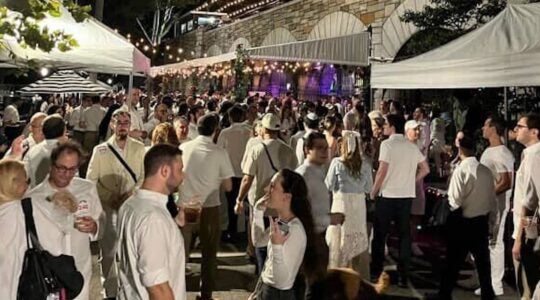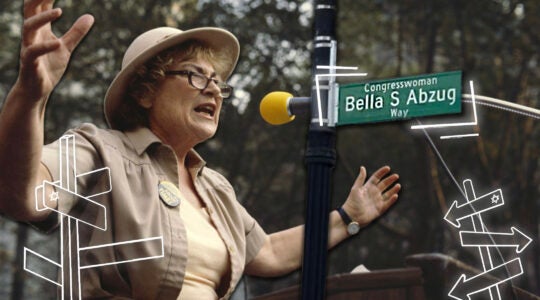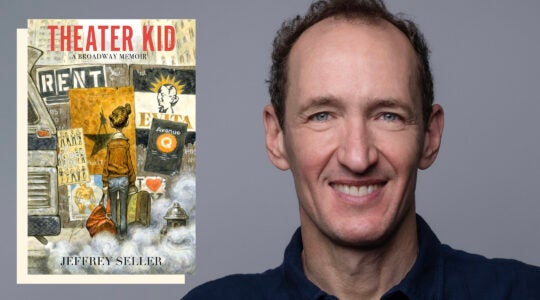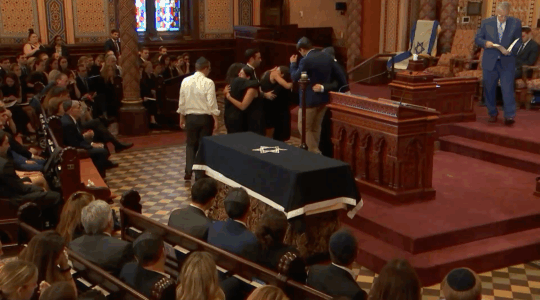Although she continued to write film criticism throughout her life, Susan Sontag’s filmmaking career was fairly brief, basically consisting of three feature films made between 1969 and 1974 (she also made a telefilm for RAI in 1983). After two fiction features, “Duet for Cannibals” (1969) and “Brother Carl” (1971), Sontag turned her hand to documentary and what would prove to be her most overt statement on Jewish matters, “Promised Lands” (1974). That rarely shown film is getting a weeklong run beginning on Feb. 4.
Sontag’s Jewish identity doesn’t figure prominently in her work. Although her interests were about as wide-ranging as those of any cultural critic of her generation, and her powers of introspection were given a good workout in several of her non-fiction books, she was a secular Jew, a “cultural Jew,” as she herself would intimate occasionally when the subject arose in interviews. So when she dashed off to Israel in the last weeks of the Yom Kippur war to make a documentary about the Jewish state, friends and colleagues were surprised.
“Promised Lands” is not a conventional documentary, which is not a surprise.
From the outset, Sontag strives to bring to the audience’s attention elements of Israel that fall outside the popular conventions of discourse on the Middle East. The film opens with footage of a Greek Orthodox monastery and its inhabitants, immediately evoking an underreported element in the country’s demographic-political mix and, tacitly, reminding viewers of another religious schism that has ended in an entente of sorts. We see one spry young priest ascend a bell tower to sound what I take to be a morning call to prayer, and then Sontag begins a spirited journey around the rooftops of Jerusalem, juxtaposing a variety of crosses with TV aerials, adding into the mix the crescents (and loudspeakers) of a minaret, and at least one neat visual pun that involves a cut from the bell ringer to a woman beating a rug, as if the ringing of the bell is coming from the carpet. Finally, the church bells fade into the gentler pastoral sound of goat bells, as we end up in a small gorge where a goatherd is ambling along with his four-footed wards.
It is a promising start and for much of the first half of the film’s 87 minutes, Sontag builds smartly on the opening’s structuring montage of unexpected opposites. Rather than recount the more familiar lineaments of the region’s history, she shows us remnants, fragments of the past that still carry a certain gravitas that bears on the present (both in 1974 and today). There is a Remembrance Day observance at the Jerusalem War Cemetery, honoring British dead from the Mandate period, intercut with debris and unburied dead from the then-current battlefield; haredim praying side by side with soldiers in combat fatigues at the Kotel; the remnants of a deserted Arab school followed by an Israeli scholar quoting from Arab grade school textbooks that read like Nazi propaganda; and the stark beauty of the moon-like rockscapes of the Negev contrasted with the rooftops of Jerusalem.
This is the sort of dialectical montage that Eisenstein dreamed of and as long as the dialectic is made up of images, the result is quite satisfying. But images don’t move an argument forward, by and large, and Sontag introduces two distinct viewpoints, brilliantly articulated but mutually incompatible, expressed by the novelist Yoram Kaniuk and the physicist Yuval Ne’eman. Kaniuk argues passionately that Israel has allowed itself to betray the socialist roots of Zionism, trading its birthright for a can of American-made stew, and that both the Israelis and the Palestinians have a right to the land. Ne’eman is just as heated in his rejection of dialogue with the Arabs, whom he regards as unwavering anti-Semites. The gulf between these viewpoints is seemingly unbridgeable and, in part as a result, the film comes to a kind of standstill, something of an hourlong deadlock that renders it repetitious and a bit tedious.
Yet there are numerous felicitous moments that make it worth sticking with “Promised Lands.” A visit to an Israeli equivalent of Madame Tussaud’s provides a rather amusing capsule version of the nation’s history. Repeated images of the wind-carved rock faces of the desert are startling in their stark beauty. The juxtaposition of the soundtrack of 19th-century chamber music and the goats’ bells has its own poignant resonance.
Sontag clearly subscribes to one of Kaniuk’s formulations. “The Jews know drama, but they don’t know tragedy,” he says at one point in the film. “We are right and [the Palestinians] are right, and we fought and fought. There’s no solution to a tragic situation and this is a tragic situation.” Ironically, the simple act of viewing “Promised Lands” in 2010 defies that hopeless analysis by underlining the fallacy of historical inevitability on all sides of the argument. At the very least, we have the advantage of three-and-a-half decades passing to remind us that, although the situation seems intractable, glacially slow change does in fact occur.
“Promised Lands” by Susan Sontag will play Thursday, Feb. 4 – Feb. 10 at 7 and 9 p.m., with additional shows at 5 p.m. on Saturday and Sunday, at Anthology Film Archives (Second Avenue and Second Street). The 7 p.m. shows on Feb. 5, 6 and 8 will includes special guests introducing the film. For information, call (212) 505-5181 or go to www.anthologyfilmarchives.org.
The New York Jewish Week brings you the stories behind the headlines, keeping you connected to Jewish life in New York. Help sustain the reporting you trust by donating today.




